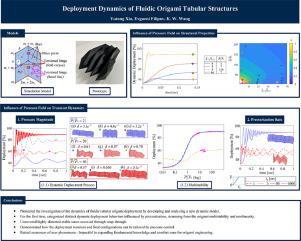流体折纸管状结构的部署动力学
IF 7.1
1区 工程技术
Q1 ENGINEERING, MECHANICAL
International Journal of Mechanical Sciences
Pub Date : 2024-11-07
DOI:10.1016/j.ijmecsci.2024.109816
引用次数: 0
摘要
折纸在工程学中的应用为空间探索、民用建筑、机器人和医疗设备等领域的可部署结构提供了创新解决方案,因为折纸能够实现紧凑折叠和扩展部署。尽管折纸具有巨大的潜力,但之前的研究主要集中在折纸的静态或运动学方面,对其动态部署行为的探索还不够。本研究针对这一空白,首次研究了折纸管状结构在空气或液体流体压力作用下的动态展开。我们引入了一种新型动态模型,该模型结合了面板惯性和弹性特性,对于捕捉刚性运动学模型所忽略的折纸展开的复杂行为以及流体压力对结构力学和动力学的影响至关重要。我们的研究结果来自非尺寸化模型,揭示了结构和输入参数对动态响应的深刻影响,标志着折纸研究取得了新的重大进展。我们对改变内部压力的流体折纸管的研究揭示了加压水平和速度如何影响系统的瞬态动力学和最终配置。引入空间不变的流体压力,以阶跃或斜坡函数的形式应用,展示了系统对压力调整的敏感性,从而影响其刚度、阻尼比和瞬态响应。这一特性带来了丰富的多稳定性图景,通过输入压力控制实现各种稳定配置的能力,并揭示了独特的动态响应,如过去未曾观察到的快穿和快退动作。总之,这些研究工作不仅推动了对压力致动管状折纸动态行为的新认识,还为开发基于折纸的系统奠定了新的基础框架,使其应用领域更加广泛,这将大大提高可重构和可部署自适应结构的设计和操作可能性。本文章由计算机程序翻译,如有差异,请以英文原文为准。

Deployment dynamics of fluidic origami tubular structures
The application of origami in engineering has offered innovative solutions for deployable structures, such as in space exploration, civil construction, robotics, and medical devices, due to its ability to enable compact folding and expansive deployment. Despite its great potential, prior studies have predominantly focused on the static or kinematic aspects of the origami, leaving the dynamic deployment behaviors underexplored. This research addresses this gap by, for the first time, investigating the dynamics of deployment of origami tubular structures actuated by fluidic pressure induced by air or liquids. We introduce a novel dynamic model that incorporates and combines panel inertia and elastic properties, critical for capturing the complex behaviors of origami deployment that rigid kinematic models overlook, as well as the fluidic pressure effects on the structural mechanics and dynamics. Our findings, derived from non-dimensionalized models, reveal the profound influences of the structural and input parameters on the dynamic responses, marking a significant new advancement in origami research. Our study on fluidic origami tubes, where internal pressure is varied, uncovers how the pressurization level and rate affect the transient dynamics and final configuration of the system. The introduction of a space-invariant fluidic pressure, applied as either a step or ramp function, demonstrates the system's sensitivity to pressure adjustments, affecting its stiffness, damping ratio, and transient response. This feature leads to a rich multistability landscape, offering the ability to achieve various stable configurations through input pressure control, and uncovering unique dynamic responses such as snap-through and snap-back actions that have not been observed in the past. All these outcomes and insights are especially valuable in raising awareness of nontraditional behaviors and expanding our comfort zone in origami engineering.
Overall, the research efforts not only propel new understanding of pressure actuated tubular origami's dynamic behaviors but also lay a novel foundational framework for developing origami-based systems for a wide array of applications, which will greatly enhance the design and operational possibilities of reconfigurable and deployable adaptive structures.
求助全文
通过发布文献求助,成功后即可免费获取论文全文。
去求助
来源期刊

International Journal of Mechanical Sciences
工程技术-工程:机械
CiteScore
12.80
自引率
17.80%
发文量
769
审稿时长
19 days
期刊介绍:
The International Journal of Mechanical Sciences (IJMS) serves as a global platform for the publication and dissemination of original research that contributes to a deeper scientific understanding of the fundamental disciplines within mechanical, civil, and material engineering.
The primary focus of IJMS is to showcase innovative and ground-breaking work that utilizes analytical and computational modeling techniques, such as Finite Element Method (FEM), Boundary Element Method (BEM), and mesh-free methods, among others. These modeling methods are applied to diverse fields including rigid-body mechanics (e.g., dynamics, vibration, stability), structural mechanics, metal forming, advanced materials (e.g., metals, composites, cellular, smart) behavior and applications, impact mechanics, strain localization, and other nonlinear effects (e.g., large deflections, plasticity, fracture).
Additionally, IJMS covers the realms of fluid mechanics (both external and internal flows), tribology, thermodynamics, and materials processing. These subjects collectively form the core of the journal's content.
In summary, IJMS provides a prestigious platform for researchers to present their original contributions, shedding light on analytical and computational modeling methods in various areas of mechanical engineering, as well as exploring the behavior and application of advanced materials, fluid mechanics, thermodynamics, and materials processing.
 求助内容:
求助内容: 应助结果提醒方式:
应助结果提醒方式:


